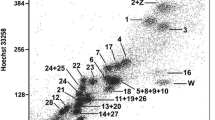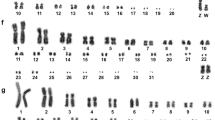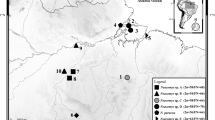Abstract
Genome-wide homology maps among stone marten (Martes foina, 2n = 38), domestic cat (Felis catus, 2n = 38), American mink (Mustela vison, 2n = 30), yellow-throated marten (Martes flavigula, 2n = 40), Old World badger (Meles meles, 2n = 44), ferret badger (Melogale moschata, 2n = 38) and red panda (Ailurus fulgens, 2n = 36) have been established by cross-species chromosome painting with a complete set of stone marten probes. In total, 18 stone marten autosomal probes reveal 20, 19, 21, 18 and 21 pairs of homologous chromosomal segments in the respective genomes of American mink, yellow-throated marten, Old World badger, ferret badger and red panda. Reciprocal painting between stone marten and cat delineated 21 pairs of homologous segments shared in both stone marten and cat genomes. The chromosomal painting results indicate that most chromosomes of these species are highly conserved and show one-to-one correspondence with stone marten and cat chromosomes or chromosomal arms, and that only a few interchromosomal rearrangements (Robertsonian fusions and fissions) have occurred during species radiation. By comparing the distribution patterns of conserved chromosomal segments in both these species and the putative ancestral carnivore karyotype, we have reconstructed the pathway of karyotype evolution of these species from the putative 2n = 42 ancestral carnivore karyotype. Our results support a close phylogenetic relationship between the red panda and mustelids. The homology data presented in these maps will allow us to transfer the cat gene mapping data to other unmapped carnivore species.
Similar content being viewed by others
References
Bininda-Emonds ORP, Gittleman JL, Purvis A (1999) Building large treesb y combining phylogenetic information: a complete phylogeny of the extant Carnivora (Mammalia). Biol Rev 74: 143–175.
Carter NP, Ferguson-Smith ME, Affara NA, Briggs H, Ferguson-Smith MA (1990) Study of X chromosome abnormality in XX malesus ing bivariate Low karyotype analysis and Low sorted dot blots. Cytometry 11: 202–207.
Cavagna P, Menotti A, Stanyon R (2000) Genomic homology of the domestic ferret with cats and humans. Mammalian Genome 11: 866–870.
Dragoo JW, Honeycutt RL (1997) Systematics of mustelid-like carnivores. J Mammal 78 (2): 426–443.
Dutrillaux B, Couturier J (1983) The ancestral karyotype of carnivoria: comparison with that of platyrrhine monkeys. Cytogenet Cell Genet 35: 200–208.
Flynn JJ, Nedbal MA (1998) Phylogeny of the Carnivora (Mammalia): congruence vsin compatibility among multiple data sets. Mol Phylogenet Evolution 9 (3): 414–426.
Frönicke L, Müller-Navia J, Romanakis K, Scherthan H (1997) Chromosomal homologies between human, harbor seal (Phoca vitulina) and the putative ancestral carnivore karyotype revealed by Zoo-FISH. Chromosoma 106: 108–113.
Graphodatsky AS, Yang F, O'Brien PCM et al. (2001) Phylogenetic implicationso f the 38 putative ancestral chromosome segments for four canid species. Cytogenet Cell Genet 92: 243–247.
Liu R, Nie W, Chen Y (1995) Chromosome study of stone marten. Zool Res (in Chinese) 16 (3): 275–279.
Mandahl N, Fredga K (1975) Q-, G-and C-band patternsof the mink chromosomes. Hereditas 81: 211–220.
Murphy WJ, Stanyon R, O'Brien SJ (2001) Evolution of mammalian genome organization inferred from comparative gene mapping. Genome Biol 2 (6): 1–8.
Nash WG, O'Brien SJ (1982) Conserved regions of homologous G-banding chromosomes between orders in mammalian evolution: carnivore and primates. Proc Natl Acad Sci USA 79: 6631–6635.
Nash WG, Wienberg J, Ferguson-Smith MA, Menninger JC, O'Brien SJ (1998) Comparative genomics: Tracking chromosome evolution in the family Ursidae using reciprocal chromosome painting. Cytogenet Cell Genet 83: 182–192.
Nie W, Liu R, Chen Y, Wang J, Yang F (1998) Mapping chromosomal homologies between humans and two largurs (Semnopithecus francoisi andS. phayrei) by chromosome painting. Chromosome Res 6: 447–453.
Nowak RM (1999) Walker's Mammals of the world. Sixth edn, Vol I. Baltimore and London Johns Hopkins University Press, pp 632–793.
Rettenberger G, Klett C, Zechner U (1995) Zoo-FISH analysis: cat and human karyotypescl osely resemble the putative ancestral mammalian karyotype. Chromosome Res 3: 479–486.
Spathas D, Ferguson-Smith MA (1993) A simpliced one step procedure for enhanced detection of biotinylated probeswi th Luorescein conjugates. Trends Genet 9: 262.
Telenius H, Pelmear AH, Tunnacliffe A et al. (1992) Cytogenetic analysis by chromosome painting using DOP-PCR ampliced Low-sorted chromosomes. Gene Chromosomes Cancer 4: 257–263.
Tian Y, Nie W, Wang J, Yang Y, Yang F (2002) Chromosome painting shows the red panda (Ailurus fulgens) hasa conserved karyotype. ACTA Genetica Sinica 29: 124–127.
Wienberg J, Stanyon R, Nash WG et al. (1997) Conservation of human vs. feline genome organization revealed by reciprocal chromosome painting. Cytogenet Cell Genet 77: 211–217.
Wozencraft WC (1989) The phylogeny of the recent Carnivora. In Wilson DE, Reeder, DM eds., ‘Carnivore Behavior, Ecology, and Evolution’ Washington, DC: Smithsonian Institution Press, pp 279–348.
Wurster-Hill DH, Bush M (1980) The interrelationship of chromosome banding patterns in the giant panda (Ailuropoda melanoleuca), hybrid bear (Ursus middendorfi x Thalarctos maritimus), and other carnivores. Cytogenet Cell Genet 27: 147–154.
Wurster-Hill DH, Centerwall WR (1982) The interrelationships of chromosome banding patterns in canids, mustelids, hyena, and felids. Cytogenet Cell Genet 34, 178–182.
Wurster-Hill DH, Gray CW (1973) Giemsa banding patterns in the chromosomeso f twelve speciesof cats (Felidae). Cytogenet Cell Genet 12: 377–397.
Wurster-Hill DH, Gray CW (1975) The interrelationships of chromosome banding patterns in procyonids viverrids, and felids. Cytogenet Cell Genet 15: 306–331.
Yang F, Carter NP, Shi L, Ferguson-Smith MA (1995) A comparative study of karyotypesof muntjacs by chromosome painting. Chromosoma 103: 642–652.
Yang F, Müller S, Just R, Ferguson-Smith MA, Wienberg J (1997) Comparative chromosome painting in mammals: Human and the Indian muntjac (Muntiacus muntjak vaginalis). Genomics 39: 396–401.
Yang F, O'Brien PCM, Milne BS et al. (1999) A complete comparative chromosome map for the dog, red fox, and human and itsi ntegration with canine genetic maps. Genomics 62,189–202.
Yang F, Graphodatsky AS, O'Brien PCM et al. (2000) Reciprocal chromosome painting illustrates the history of genome evolution of the domestic cat, dog and human. Chromosome Res 8: 393–404.
Author information
Authors and Affiliations
About this article
Cite this article
Nie, W., Wang, J., O'Brien, P.C. et al. The genome phylogeny of domestic cat, red panda and five mustelid species revealed by comparative chromosome painting and G-banding. Chromosome Res 10, 209–222 (2002). https://doi.org/10.1023/A:1015292005631
Issue Date:
DOI: https://doi.org/10.1023/A:1015292005631




